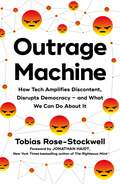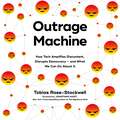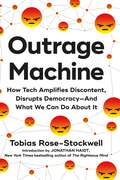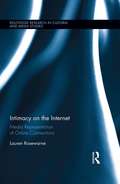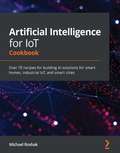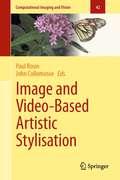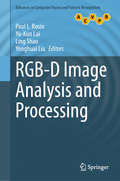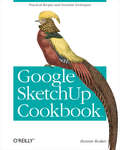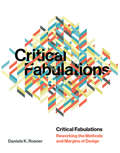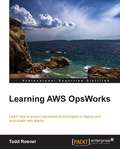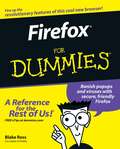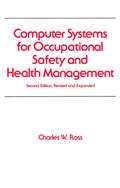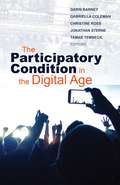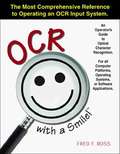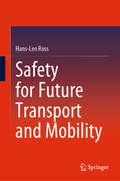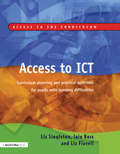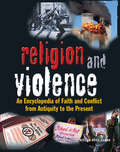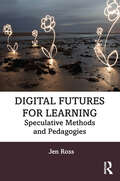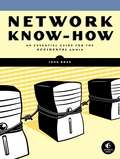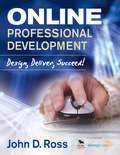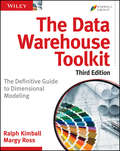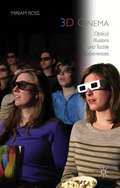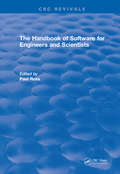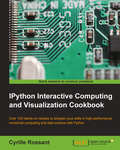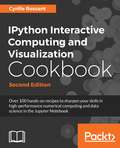- Table View
- List View
Outrage Machine: How Tech Amplifies Discontent, Disrupts Democracy – and What We Can Do About It
by Tobias Rose-StockwellForeword by Jonathan Haidt, author of THE RIGHTEOUS MINDAn invaluable guide to understanding the technology that captures our attention with anger.The original internet was not designed to make us upset, distracted, confused, and outraged. But something unexpected happened at the turn of the last decade, when a handful of small features were quietly launched at social media companies with little fanfare. Together, they triggered a cascading set of dramatic changes to how media, politics, and society itself operates-inadvertently creating an Outrage Machine we cannot ignore.Author, designer, and media researcher Tobias Rose-Stockwell shares the defining shifts caused by these technologies, and how they have ignited a society-wide crisis of trust. Drawing from cutting-edge research and vivid personal anecdotes, Rose-Stockwell illustrates how social media has bound us to an unprecedented system of public performance, training us to react rather than reflect, and attack rather than debate.OUTRAGE MACHINE reveals the triggers and tactics used to exploit our anger, unpacking how these tools hack our deep tribal instincts and psychological vulnerabilities, and how they have become opportunistic platforms for authoritarians and a threat to democratic norms everywhere.But this book is not just about the problem. In a story spanning continents and generations, Rose-Stockwell explores how every new media technology disrupts our ability to make sense of the world, from the printing press to the telegraph, from radio to television. OUTRAGE MACHINE situates social media within a historical cycle of confusion, violence, and emerging tolerance. Using clear language and powerful illustrations, this book reveals the magnitude of the challenges we face, while offering realistic solutions and a promising pathway out.
Outrage Machine: How Tech Amplifies Discontent, Disrupts Democracy – and What We Can Do About It
by Tobias Rose-StockwellForeword by Jonathan Haidt, author of THE RIGHTEOUS MINDAn invaluable guide to understanding the technology that captures our attention with anger.The original internet was not designed to make us upset, distracted, confused, and outraged. But something unexpected happened at the turn of the last decade, when a handful of small features were quietly launched at social media companies with little fanfare. Together, they triggered a cascading set of dramatic changes to how media, politics, and society itself operates-inadvertently creating an Outrage Machine we cannot ignore.Author, designer, and media researcher Tobias Rose-Stockwell shares the defining shifts caused by these technologies, and how they have ignited a society-wide crisis of trust. Drawing from cutting-edge research and vivid personal anecdotes, Rose-Stockwell illustrates how social media has bound us to an unprecedented system of public performance, training us to react rather than reflect, and attack rather than debate.OUTRAGE MACHINE reveals the triggers and tactics used to exploit our anger, unpacking how these tools hack our deep tribal instincts and psychological vulnerabilities, and how they have become opportunistic platforms for authoritarians and a threat to democratic norms everywhere.But this book is not just about the problem. In a story spanning continents and generations, Rose-Stockwell explores how every new media technology disrupts our ability to make sense of the world, from the printing press to the telegraph, from radio to television. OUTRAGE MACHINE situates social media within a historical cycle of confusion, violence, and emerging tolerance. Using clear language and powerful illustrations, this book reveals the magnitude of the challenges we face, while offering realistic solutions and a promising pathway out.
Outrage Machine: How Tech Amplifies Discontent, Disrupts Democracy—And What We Can Do About It
by Tobias Rose-StockwellAmazon's Best History Book of the Month for July 2023An invaluable guide to understanding how the internet has broken our brains—and what we can do to fix it. The original internet was not designed to make us upset, distracted, confused, and outraged. But something unexpected happened at the turn of the last decade, when a handful of small features were quietly launched at social media companies with little fanfare. Together, they triggered a cascading set of dramatic changes to how media, politics, and society itself operate—inadvertently creating an Outrage Machine we cannot ignore. Author, designer, and media researcher Tobias Rose-Stockwell shares the defining shifts caused by these technologies, and how they have ignited a society-wide crisis of trust. Drawing from cutting-edge research and vivid personal anecdotes, Rose-Stockwell illustrates how social media has bound us to an unprecedented system of public performance, training us to react rather than reflect, and attack rather than debate.Outrage Machine reveals the triggers and tactics used to exploit our anger, unpacking how these tools hack our deep tribal instincts and psychological vulnerabilities, and how they have become opportunistic platforms for authoritarians and a threat to democratic norms everywhere. But this book is not just about the problem. In a story spanning continents and generations, Rose-Stockwell explores how every new media technology disrupts our ability to make sense of the world, from the printing press to the telegraph, from radio to television. Outrage Machine situates social media within a historical cycle of confusion, violence, and emerging tolerance. Using clear language and powerful illustrations, this book reveals the magnitude of the challenges we face, while offering realistic solutions and a promising pathway out.
Intimacy on the Internet: Media Representations of Online Connections (Routledge Research in Cultural and Media Studies)
by Lauren RosewarneThe focus of this book is on the media representations of the use of the Internet in seeking intimate connections—be it a committed relationship, a hook-up, or a community in which to dabble in fringe sexual practices. Popular culture (film, narrative television, the news media, and advertising) present two very distinct pictures of the use of the Internet as related to intimacy. From news reports about victims of online dating, to the presentation of the desperate and dateless, the perverts and the deviants, a distinct frame for the intimacy/Internet connection is negativity. In some examples however, a changing picture is emerging. The ubiquitousness of Internet use today has meant a slow increase in comparatively more positive representations of successful online romances in the news, resulting in more positive-spin advertising and a more even-handed presence of such liaisons in narrative television and film. Both the positive and the negative media representations are categorised and analysed in this book to explore what they reveal about the intersection of gender, sexuality, technology and the changing mores regarding intimacy.
Artificial Intelligence for IoT Cookbook: Over 70 recipes for building AI solutions for smart homes, industrial IoT, and smart cities
by Michael RoshakImplement machine learning and deep learning techniques to perform predictive analytics on real-time IoT dataKey FeaturesDiscover quick solutions to common problems that you'll face while building smart IoT applicationsImplement advanced techniques such as computer vision, NLP, and embedded machine learningBuild, maintain, and deploy machine learning systems to extract key insights from IoT dataBook DescriptionArtificial intelligence (AI) is rapidly finding practical applications across a wide variety of industry verticals, and the Internet of Things (IoT) is one of them. Developers are looking for ways to make IoT devices smarter and to make users' lives easier. With this AI cookbook, you'll be able to implement smart analytics using IoT data to gain insights, predict outcomes, and make informed decisions, along with covering advanced AI techniques that facilitate analytics and learning in various IoT applications. Using a recipe-based approach, the book will take you through essential processes such as data collection, data analysis, modeling, statistics and monitoring, and deployment. You'll use real-life datasets from smart homes, industrial IoT, and smart devices to train and evaluate simple to complex models and make predictions using trained models. Later chapters will take you through the key challenges faced while implementing machine learning, deep learning, and other AI techniques, such as natural language processing (NLP), computer vision, and embedded machine learning for building smart IoT systems. In addition to this, you'll learn how to deploy models and improve their performance with ease. By the end of this book, you'll be able to package and deploy end-to-end AI apps and apply best practice solutions to common IoT problems.What you will learnExplore various AI techniques to build smart IoT solutions from scratchUse machine learning and deep learning techniques to build smart voice recognition and facial detection systemsGain insights into IoT data using algorithms and implement them in projectsPerform anomaly detection for time series data and other types of IoT dataImplement embedded systems learning techniques for machine learning on small devicesApply pre-trained machine learning models to an edge deviceDeploy machine learning models to web apps and mobile using TensorFlow.js and JavaWho this book is forIf you're an IoT practitioner looking to incorporate AI techniques to build smart IoT solutions without having to trawl through a lot of AI theory, this AI IoT book is for you. Data scientists and AI developers who want to build IoT-focused AI solutions will also find this book useful. Knowledge of the Python programming language and basic IoT concepts is required to grasp the concepts covered in this artificial intelligence book more effectively.
Image and Video-Based Artistic Stylisation
by Paul Rosin John CollomosseNon-photorealistic rendering (NPR) is a combination of computer graphics and computer vision that produces renderings in various artistic, expressive or stylized ways such as painting and drawing. This book focuses on image and video based NPR, where the input is a 2D photograph or a video rather than a 3D model. 2D NPR techniques have application in areas as diverse as consumer and professional digital photography and visual effects for TV and film production. The book covers the full range of the state of the art of NPR with every chapter authored by internationally renowned experts in the field, covering both classical and contemporary techniques. It will enable both graduate students in computer graphics, computer vision or image processing and professional developers alike to quickly become familiar with contemporary techniques, enabling them to apply 2D NPR algorithms in their own projects.
RGB-D Image Analysis and Processing (Advances in Computer Vision and Pattern Recognition)
by Paul L. Rosin Yu-Kun Lai Ling Shao Yonghuai LiuThis book focuses on the fundamentals and recent advances in RGB-D imaging as well as covering a range of RGB-D applications. The topics covered include: data acquisition, data quality assessment, filling holes, 3D reconstruction, SLAM, multiple depth camera systems, segmentation, object detection, salience detection, pose estimation, geometric modelling, fall detection, autonomous driving, motor rehabilitation therapy, people counting and cognitive service robots. The availability of cheap RGB-D sensors has led to an explosion over the last five years in the capture and application of colour plus depth data. The addition of depth data to regular RGB images vastly increases the range of applications, and has resulted in a demand for robust and real-time processing of RGB-D data. There remain many technical challenges, and RGB-D image processing is an ongoing research area. This book covers the full state of the art, and consists of a series of chapters by internationally renowned experts in the field. Each chapter is written so as to provide a detailed overview of that topic. RGB-D Image Analysis and Processing will enable both students and professional developers alike to quickly get up to speed with contemporary techniques, and apply RGB-D imaging in their own projects.
Google SketchUp Cookbook: Practical Recipes and Essential Techniques
by Bonnie RoskesAs the first book for intermediate and advanced users of Google SketchUp, this Cookbook goes beyond the basics to explore the complex features and tools that design professionals use. You'll get numerous step-by-step tutorials for solving common (and not so common) design problems, with detailed color graphics to guide your way, and discussions that explain additional ways to complete a task. Google SketchUp Cookbook will help you: Use SketchUp more efficiently by taking advantage of components and groups Learn new techniques for using Follow Me, Intersect, and constraints Go beyond simple textures with tools such as texture positioning and Photo Match Create animations and walkthroughs, and explore design scenarios by using layers and scenes Learn how to use styles to customize your presentations Combine SketchUp with the 3D Warehouse and Google Earth Google SketchUp Cookbook is ideal for architects, engineers, interior designers, product designers, woodworkers, and other professionals and hobbyists who want to work more efficiently and achieve true mastery of this amazing tool.
Critical Fabulations: Reworking the Methods and Margins of Design (Design Thinking, Design Theory)
by Daniela K RosnerA proposal to redefine design in a way that not only challenges the field's dominant paradigms but also changes the practice of design itself.In Critical Fabulations, Daniela Rosner proposes redefining design as investigative and activist, personal and culturally situated, responsive and responsible. Challenging the field's dominant paradigms and reinterpreting its history, Rosner wants to change the way we historicize the practice, reworking it from the inside. Focusing on the development of computational systems, she takes on powerful narratives of innovation and technology shaped by the professional expertise that has become integral to the field's mounting status within the new industrial economy. To do so, she intervenes in legacies of design, expanding what is considered “design” to include long-silenced narratives of practice, and enhancing existing design methodologies based on these rediscovered inheritances. Drawing on discourses of feminist technoscience, she examines craftwork's contributions to computing innovation—how craftwork becomes hardware manufacturing, and how hardware manufacturing becomes craftwork. She reclaims, for example, NASA's “Little Old Ladies,” the women who built information storage for the Apollo missions by weaving wires through magnetized metal rings.Mixing history, theory, personal experience, and case studies, Rosner reweaves fibers of technoscience by slowly reworking the methods and margins of design. She suggests critical fabulations as ways of telling stories that awaken alternative histories, and offers a set of techniques and orientations for fabulating its future. Critical Fabulations shows how design's hidden inheritances open different possibilities for practice.
Learning AWS OpsWorks
by Todd RosnerA fast-paced, example-based guide to mastering AWS OpsWorks.This book is geared towards application developers, system administrators, DevOps, and anyone else interested in delivering applications while managing highly-scalable and automated infrastructures using push-button procedures. Some knowledge of what cloud computing is as well as some familiarity with Amazon Web Services is all you need as a precursor to reading this book.
Firefox For Dummies
by Blake RossFirefox For Dummies gives you the inside scoop on the exciting new browser from the Web wizard that got it started. The book's author, Blake Ross, began developing Firefox as a teenager. Once available to the world, the simple and powerful tool was an instant hit claiming a sizable share of the Web browser market with over 140 million downloads. In this book Blake not only gives you the lowdown on how to use Firefox for safe Web searching, but he also shares his insight into how the product came to life. It's a combination of practical tech insight and a good story that is rare in computer books. Topics covered include downloading and installing Firefox, creating a home page, searching with Google, creating customized themes and toolbars, using tabbed browsing, downloading and saving files, maintaining security and privacy, eliminating annoying popups, and adding Firefox extensions.
Computer Systems for Occupational Safety and Health Management
by Charles W. RossThis book describes how safety and other professionals may use safety database software on a personal computer to manage their safety and health programs. It emphasizes the techniques and features necessary to develop a computerized safety data system for a personal computer.
The Participatory Condition in the Digital Age
by Christine Ross Darin Barney Jonathan Sterne Tamar Tembeck Gabriella ColemanJust what is the "participatory condition"? It is the situation in which taking part in something with others has become both environmental and normative. The fact that we have always participated does not mean we have always lived under the participatory condition. What is distinctive about the present is the extent to which the everyday social, economic, cultural, and political activities that comprise simply being in the world have been thematized and organized around the priority of participation. Structured along four axes investigating the relations between participation and politics, surveillance, openness, and aesthetics, The Participatory Condition in the Digital Age comprises fifteen essays that explore the promises, possibilities, and failures of contemporary participatory media practices as related to power, Occupy Wall Street, the Arab Spring uprisings, worker-owned cooperatives for the post-Internet age; paradoxes of participation, media activism, open source projects; participatory civic life; commercial surveillance; contemporary art and design; and education. This book represents the most comprehensive and transdisciplinary endeavor to date to examine the nature, place, and value of participation in the digital age. Just as in 1979, when Jean-François Lyotard proposed that "the postmodern condition" was characterized by the questioning of historical grand narratives, The Participatory Condition in the Digital Age investigates how participation has become a central preoccupation of our time. Contributors: Mark Andrejevic, Pomona College; Bart Cammaerts, London School of Economics and Political Science (LSE); Nico Carpentier, Vrije Universiteit Brussel (VUB - Free University of Brussels) and Charles University in Prague; Julie E. Cohen, Georgetown University; Kate Crawford, MIT; Alessandro Delfanti, University of Toronto; Christina Dunbar-Hester, University of Southern California; Rudolf Frieling, California College of Arts and the San Francisco Art Institute; Salvatore Iaconesi, La Sapienza University of Rome and ISIA Design Florence; Jason Edward Lewis, Concordia University; Rafael Lozano-Hemmer; Graham Pullin, University of Dundee; Trebor Scholz, The New School in New York City; Cayley Sorochan, McGill University; Bernard Stiegler, Institute for Research and Innovation in Paris; Krzysztof Wodiczko, Harvard Graduate School of Design; Jillian C. York.
OCR with a Smile!: An Operator's Guide to Optical Character Recognition
by Fred F. RossThis informative and easy to read book explains OCR as well as problems and fixes that might arise in the process.
Safety for Future Transport and Mobility
by Hans-Leo RossThe book provides background information about technical solutions, processes and methodology to develop future automated mobility solutions. Beginning from the legal requirements as the minimum tolerable risk level of the society, the book provides state-of-the-art risk-management methodologies. The system engineering approach based on todays engineering best practices enhanced by principles derived from cybernetics. The approach derived from the typical behaviour of a human driver in public road traffic to a cybernetical based system engineering approach. Beyond the system engineering approach, a common behaviour model for the operational domain will show aspects how to extend the system engineering model with principles of cybernetics. The role and the human factors of road traffic participants and drivers of motor vehicles are identified and several viewpoints for different observers show how such mixed traffic scenarios could be assessed and optimised. The influence of the changing mobility demands of the society and the resulting changes to the origination of producer, owner, driver and supplier show aspects for future liability and risk share option for new supply chains. Examples from various industries provide some well-proven engineering principles how to adapt those for the future mobility for the benefit of the users. The aim of the book is to raise awareness that the safety provided by a product, a means of transport or a system up to an entire traffic system depends on the capabilities of the various actors. In addition to the driver and passengers, there are also other road users, maintenance personnel and service providers, who must have certain abilities to act safely in traffic. These are also the capabilities of the organisation, not only the organisation that develops or brings the product to market, but also the organisation that is responsible for the operation and the whole lifecycle of the products. The book is for people who want to get involved in the mobility of the future. People, that have ideas to become a player who want to help shape the future mobility of society and who want to bring responsible solutions for users into the market.
Access to ICT: Curriculum Planning and Practical Activities for Pupils with Learning Difficulties
by Iain Ross Liz Singleton Liz FlavellFirst Published in 2005. Routledge is an imprint of Taylor & Francis, an informa company.
Religion and Violence: An Encyclopedia of Faith and Conflict from Antiquity to the Present
by Jeffrey Ian RossFirst Published in 2015. Daily newspaper headlines, talk radio and cable television broadcasts, and Internet news web sites continuously highlight the relationship between religion and violence. These media contain stories about such diverse incidents as suicide attacks by Islamic fundamentalists in Afghanistan, Iraq, Israel, Pakistan, and elsewhere, and assassinations of doctors who perform abortions by white American Christian true believers in the United States. How does one make sense of the role of religion in violence, and of perpetrators of violence who cite religion as a motivation? This encyclopedia includes a wide range of entries: biographies of key figures, historical events, religious groups, countries and regions where religion and violence have intersected, and practices, rituals, and processes of religious violence.
Digital Futures for Learning: Speculative Methods and Pedagogies
by Jen RossDigital Futures for Learning offers a methodological and pedagogical way forward for researchers and educators who want to work imaginatively with "what’s next" in higher education and informal learning. Today’s debates around technological transformations of social, cultural and educational spaces and practices need to be informed by a more critical understanding of how visions of the future of learning are made and used, and how they come to be seen as desirable, inevitable or impossible. Integrating innovative methods, key research findings, engaging theories and creative pedagogies across multiple disciplines, this book argues for and explores speculative approaches to researching and analysing post-compulsory and informal learning futures – where we are, where we might go and how to get there.
Network Know-How: An Essential Guide for the Accidental Admin
by John RossAre the machines in your office living isolated lives? Do you have a few computers at home that you want to connect to each other and the Internet? The best way to share files on a group of computers is to create a network. But how do you do that?Network Know-How is your guide to connecting your machines, filled with practical advice that will show you how to get things done. You'll learn the nitty-gritty of network setup, design, and maintenance, from running cables and placing wireless access points to configuring file sharing and printing. This practical and comprehensive guide will teach you how to implement security, create intranets, and more. You'll learn how to:–Connect Windows, Macintosh, and Linux computers–Implement network addressing–Configure your network adapters, hubs, switches, and router–Share music, photos, and documents–Automate household appliances and stream digital audio and video to your home entertainment center–Troubleshoot network slowdowns and failuresNo matter which operating system you use, and even if you’ve never installed or run a network before, you’ll get what you need to know in Network Know-How.
Online Professional Development: Design, Deliver, Succeed!
by John D. RossMuch-needed direction for navigating online professional development Online professional development expert John D. Ross’s practical framework will help you ask the right questions and make sound development and purchasing decisions. Based on proven principles of professional learning and instructional design, he guides you through charting your course to success and provides a path to answering these fundamental questions: <p><p> Why do I need OPD? <p> How much does it cost? <p> How do I get started? <p> What does high-quality online learning look like? <p> What technologies are right for me? <p> Did it work?
The Data Warehouse Toolkit
by Margy Ross Ralph KimballThe latest edition of the single most authoritative guide on dimensional modeling for data warehousing! Dimensional modeling has become the most widely accepted approach for data warehouse design. Here is a complete library of dimensional modeling techniques-- the most comprehensive collection ever written. Greatly expanded to cover both basic and advanced techniques for optimizing data warehouse design, this second edition to Ralph Kimball's classic guide is more than sixty percent updated. The authors begin with fundamental design recommendations and gradually progress step-by-step through increasingly complex scenarios. Clear-cut guidelines for designing dimensional models are illustrated using real-world data warehouse case studies drawn from a variety of business application areas and industries, including: * Retail sales and e-commerce * Inventory management * Procurement * Order management * Customer relationship management (CRM) * Human resources management * Accounting * Financial services * Telecommunications and utilities * Education * Transportation * Health care and insurance By the end of the book, you will have mastered the full range of powerful techniques for designing dimensional databases that are easy to understand and provide fast query response. You will also learn how to create an architected framework that integrates the distributed data warehouse using standardized dimensions and facts. This book is also available as part of the Kimball's Data Warehouse Toolkit Classics Box Set (ISBN: 9780470479575) with the following 3 books: The Data Warehouse Toolkit, 2nd Edition (9780471200246) The Data Warehouse Lifecycle Toolkit, 2nd Edition (9780470149775) The Data Warehouse ETL Toolkit (9780764567575)
3D Cinema
by Miriam Ross3D Cinema: Optical Illusions and Tactile Experiences questions the common frameworks used for discussing 3D cinema, realism and spectacle, in order to fully understand the embodied and sensory dimensions of 3D cinema's unique visuality.
Revival: The Handbook of Software for Engineers and Scientists (CRC Press Revivals)
by Paul W RossThe Handbook of Software for Engineers and Scientists is a single-volume, ready reference for the practicing engineer and scientist in industry, government, and academia as well as the novice computer user. It provides the most up-to-date information in a variety of areas such as common platforms and operating systems, applications programs, networking, and many other problem-solving tools necessary to effectively use computers on a daily basis.Specific platforms and environments thoroughly discussed include MS-DOS®, Microsoft® Windows™, the Macintosh® and its various systems, UNIX™, DEC VAX™, IBM® mainframes, OS/2®, Windows™ NT, and NeXTSTEP™. Word processing, desktop publishing, spreadsheets, databases, integrated packages, computer presentation systems, groupware, and a number of useful utilities are also covered. Several extensive sections in the book are devoted to mathematical and statistical software. Information is provided on circuits and control simulation programs, finite element tools, and solid modeling tools.
IPython Interactive Computing and Visualization Cookbook
by Cyrille RossantIntended to anyone interested in numerical computing and data science: students, researchers, teachers, engineers, analysts, hobbyists... Basic knowledge of Python/NumPy is recommended. Some skills in mathematics will help you understand the theory behind the computational methods.
IPython Interactive Computing and Visualization Cookbook, Second Edition: Over 100 hands-on recipes to sharpen your skills in high-performance numerical computing and data science in the Jupyter Notebook
by Cyrille RossantLearn to use IPython and Jupyter Notebook for your data analysis and visualization work. Key Features Leverage the Jupyter Notebook for interactive data science and visualization Become an expert in high-performance computing and visualization for data analysis and scientific modeling A comprehensive coverage of scientific computing through many hands-on, example-driven recipes with detailed, step-by-step explanations Book Description Python is one of the leading open source platforms for data science and numerical computing. IPython and the associated Jupyter Notebook offer efficient interfaces to Python for data analysis and interactive visualization, and they constitute an ideal gateway to the platform. IPython Interactive Computing and Visualization Cookbook, Second Edition contains many ready-to-use, focused recipes for high-performance scientific computing and data analysis, from the latest IPython/Jupyter features to the most advanced tricks, to help you write better and faster code. You will apply these state-of-the-art methods to various real-world examples, illustrating topics in applied mathematics, scientific modeling, and machine learning. The first part of the book covers programming techniques: code quality and reproducibility, code optimization, high-performance computing through just-in-time compilation, parallel computing, and graphics card programming. The second part tackles data science, statistics, machine learning, signal and image processing, dynamical systems, and pure and applied mathematics. What you will learn Master all features of the Jupyter Notebook Code better: write high-quality, readable, and well-tested programs; profile and optimize your code; and conduct reproducible interactive computing experiments Visualize data and create interactive plots in the Jupyter Notebook Write blazingly fast Python programs with NumPy, ctypes, Numba, Cython, OpenMP, GPU programming (CUDA), parallel IPython, Dask, and more Analyze data with Bayesian or frequentist statistics (Pandas, PyMC, and R), and learn from actual data through machine learning (scikit-learn) Gain valuable insights into signals, images, and sounds with SciPy, scikit-image, and OpenCV Simulate deterministic and stochastic dynamical systems in Python Familiarize yourself with math in Python using SymPy and Sage: algebra, analysis, logic, graphs, geometry, and probability theory Who this book is for This book is intended for anyone interested in numerical computing and data science: students, researchers, teachers, engineers, analysts, and hobbyists. A basic knowledge of Python/NumPy is recommended. Some skills in mathematics will help you understand the theory behind the computational methods.
